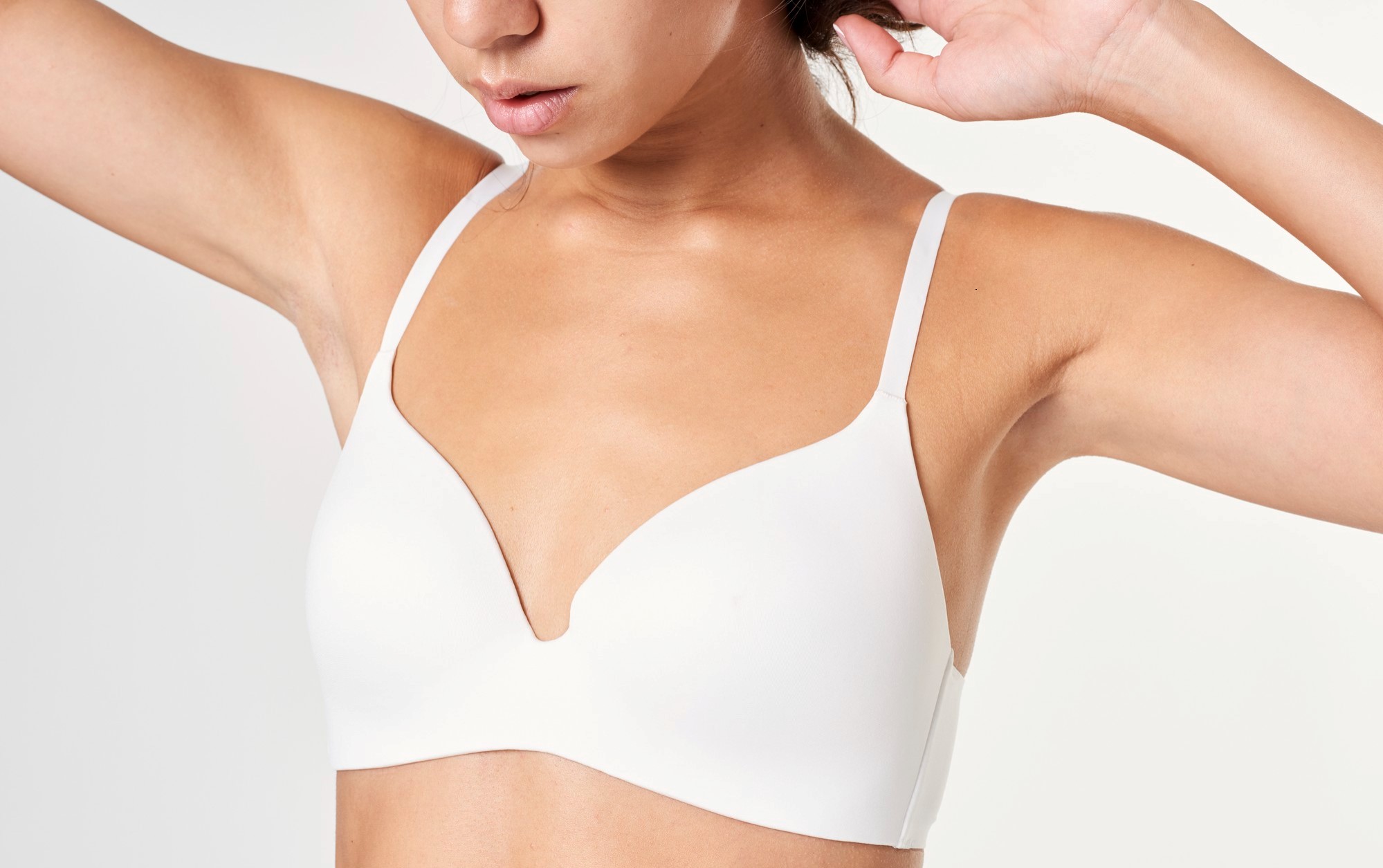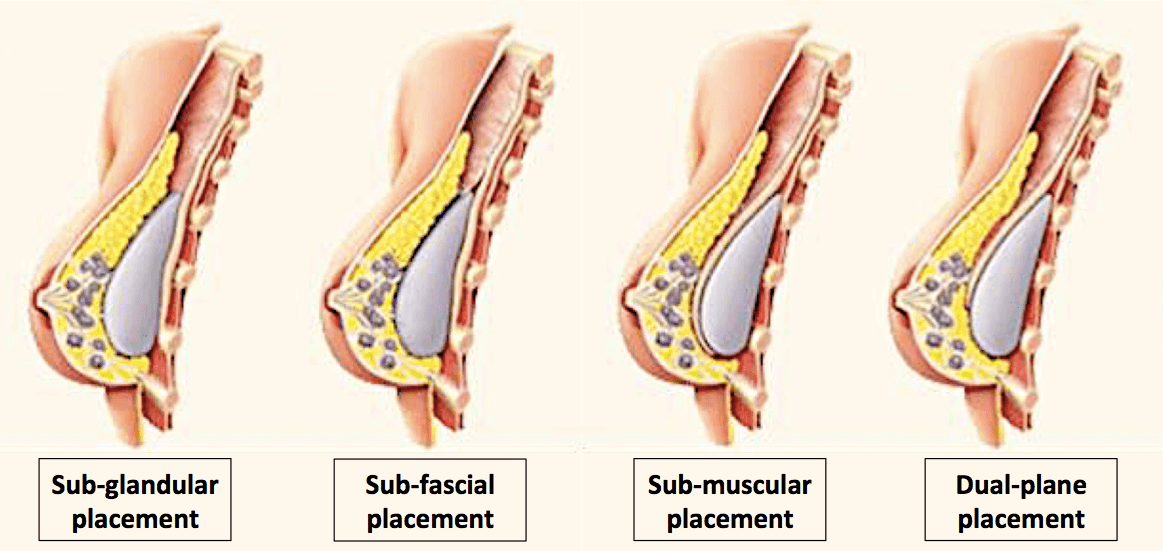Should breast implants be placed above the muscle or below the muscle? Which method is the best?
There is no best answer for any one person. Each individual’s physical characteristics and physique determine the best method for them. The solution is to look for an experienced and skilful plastic surgeon who can give the best recommendation for your needs.
Here is some useful information for you to make an informed choice.
BREAST IMPLANT PLACEMENT
The sub-glandular technique, or over-the-muscle placement, places the implants between the breast tissue and the chest muscle.
The sub-fascial technique involves elevating the layer covering the outer surface of the chest muscle and placing the breast implants in the space created.
The sub-muscular technique, under the muscle placement, means putting the implant below the pectoralis major or chest muscle.
The dual-plane technique involves both the sub-muscular and sub-glandular techniques. The upper part of the breast implant is sub-muscular, which means the placement of the implant in a pocket underneath the chest muscle, while the lower part of the implant is covered only by the breast tissue.
Note that all of these techniques place breast implants UNDER the mammary glands, which still allows for breastfeeding.
SUB-GLANDULAR BREAST IMPLANT PLACEMENT (OVER THE MUSCLE)
Advantages:
- Achieves a more rounded, augmented look, which some women prefer.
- Implants can be placed slightly closer together to achieve more cleavage.
- The breast implants do not become distorted when the pectoral muscles are flexed, which makes them a good choice for women who lift weights regularly.
- The surgical procedure is slightly easier and perceived as less invasive. This also means that there is less postoperative pain as compared to under-the-muscle placement.
Disadvantages:
- Only advisable for women who have a good amount of their own breast tissue (B-cup or larger). This is so that there will be adequate soft tissue covering the breast implants to reduce the risk of breast implant visibility (palpability) and rippling, especially over time.
- For patients with smaller amounts of breast tissue, bigger implants result in a less natural outcome. (Note: Different degrees of projections can be chosen to suit the chest width to get a more natural outcome.)
- With less tissue covering the breast implant (only skin as compared to under the muscle technique), the breast might be more susceptible to visible rippling in the future.
- Although technology allows for better breast imaging, with or without implants, the over-the-muscle technique is generally thought to require more mammogram views due to the shadow present.
- Based on clinical studies, the sub-glandular technique has a higher rate of capsular contracture formation due to constant muscle movement. Patients are advised to massage the implant to reduce the risk of capsular contracture formation.
SUB-FASCIAL BREAST IMPLANT PLACEMENT
Advantages: The advantages of the sub-fascial technique are similar to the sub-glandular technique. But it comes with an additional feature: a strong fibrous sheath and breast tissue that supports the implant.
Disadvantages: The disadvantages of the sub-fascial technique are similar to the sub-glandular technique.
SUB-MUSCULAR BREAST IMPLANT PLACEMENT (UNDER THE MUSCLE)
Advantages:
- Suitable for women with any amount of breast tissue.
- Achieves a more natural look with natural sloping upper poles.
- With more soft tissue padding on the breast implants, there is a reduced risk of breast implant visibility and rippling in the long run.
- Less chance of sagging as the weight of the breast implant is supported by both breast tissue and chest muscle.
- Less likely to interfere with mammography.
- Reduced risk of capsular contracture formation.
Disadvantages:
- The breast might appear to sit in a higher position until the muscle fully relaxes in about 4-6 weeks after surgery.
- This technique might not be advisable for women who regularly lift weights as it might cause implant distortion when the chest muscle is flexed.
- The surgical procedure is perceived as more invasive. This also means that there is slightly more post-operative pain and longer recovery time than the over-the-muscle placement.
- Not advisable for patients with too much flabby/hanging breast skin as there is a chance of the skin hanging over the implant in the long run.
DUAL-PLANE BREAST IMPLANT PLACEMENT
Advantages:
- Combines both advantages of sub-glandular and sub-muscular techniques.
- By releasing the attachments of the overlaying breast tissue to the pectoralis major muscle to varying degrees based on individual anatomy, the best-looking breast can be customized to suit each patient.
- A natural result is particular for patients with very small breasts, as both the breast muscle and tissue cover the upper pole of the implant.
- Lower risk of the formation of capsular contracture.
- The possibility of implant dropping is reduced as the muscle and fascia secure the implant and keep it in the right position.
- Possibility of reduced palpability of implant borders.
- Lower risk of wrinkles forming on the upper part of the body.
Disadvantages – The disadvantages of the dual-plane technique are similar to the sub-muscular technique.
Given this, it is still up to your individual physical characteristics and preferences to determine which technique is best for you. Discuss all the advantages and disadvantages with an experienced plastic surgeon before deciding.
To learn more about the different breast implant placements, do contact us at:
Dr Marco Faria-Correa Plastic Surgery
Tel: +65 64648075
E-mail: enquiry@drmarco.com
Web: www.drmarco.com
Disclaimer: The information contained in this post is neither intended nor implied to be a substitute for professional medical advice. It is provided for educational purposes only. Always seek the advice of your plastic surgeon or other qualified healthcare provider before starting any new treatment or discontinuing an existing treatment. Always speak to your healthcare provider about any questions you may have regarding a procedure.


